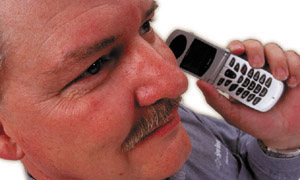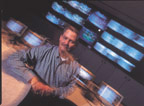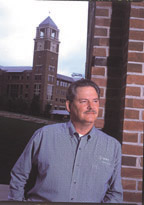Sprinting to Success

It possesses its own zip code. If incorporated, it would become the 27th largest city within the state of Kansas. But no one lives there. What's the city? Well, it's not a city but the new Sprint campus in Overland Park, Kansas.
Sprint is a global communications company - at the forefront of integrating long-distance, local and wireless communications services, and a large carrier of Internet traffic. Sprint built and operates the United States' first nationwide all-digital, fiber-optic network and is a leader in advanced data communications services. With annual revenues of more than $23 billion and serving more than 20 million businesses and residential customers, Sprint has more than 81,000 employees nationwide. Founded in 1899, the company maintains its world headquarters in Kansas City. Until now that is. The process has begun to move the 14,500 Sprint employees from Kansas City to their new home in Overland Park.
Situated on approximately 200 acres, 60 percent is dedicated to green space, ranging from landscaped courtyards to lakes and wetlands. The campus resembles that of an ivy-league college.
This ground-up construction began in 1989 with the purchase of the property, and seven years later the master plan was approved. Although the grand opening took place in October 1999, the finished product isn't going to be ready for approximately 2 1/2 years. A total of 8,000 of an estimated 14,500 employees are currently working out of the campus today.
Dedicated to Excellence
Sprint's long term success is dependent upon being responsive to both technological and market changes in one of the most dynamic industries in the world. Sprint's campus has been designed to reinforce Sprint's service-oriented, market-responsive culture and to facilitate change over short periods of time."When I took over for security at Sprint, I wanted to choose a product that would be capable of handling growth and activity that we foresaw while working for Sprint PCS. We were going to have growth that was unprecedented in the telecommunications industry in the period of time in which we set our goals," says Joseph Mansfield, director of corporate physical security at Sprint.
How do you physically protect an area that has its own zip code? With the help of Kroll-Schiff & Associates, Bastrop, Tex., the security consultants on the project and Security Technologies Group, Sunrise Fla., the systems integrators, the triumvirate was able to integrate the latest security technology in the industry.
Kroll has been providing the kind of assistance that helps clients take control of their businesses - including risks relating to a wide range of current and potential difficulties. They may include internal controls, employee or vendor malfeasance, threats to corporate security, intellectual property theft, and financial improprieties.
"Our role is to make sure that we have set standards for Sprint and all of their facilities, what they need in the call center, what they need in the field office and office facility. We've worked with them to help them write standards and to make sure that they are implemented and followed out. Once the design was finished by Schiff, we sat down and discussed the standards," says Adam Stanislaus, Security Technologies Group, Sunrise, Fla.
"There are some innovations at the campus that we don't have at other Sprint locations throughout the country simply because of the nature of the beast. We are building a facility with state-of-the-art security. We are putting in new technology that has never been used in the past with Sprint. We are using it to develop and pioneer a national standard and distribute it out to our other locations," says Mansfield.
What constitutes "state-of-the-art"? According to Mansfield and the Sprint security team, it is a facility that features an integrated security system that combines access control, CCTV, Web-hosting badging and possible biometric methods.

Safe Access
Creating safe access control for the project was done by using the CoCURE 800/8000 by Software House, Boston, Mass., a division of Sensormatic. It is a scalable, security management solution suitable for large and small installations alike. It seamlessly integrates numerous applications including access control and alarm monitoring, e-mail, paging, RFID technology, CCTV, elevator control, and photo imaging."I wanted a system that was capable of handling a myriad of types of facilities and business operations that we had. Software House had developed their applications to fit those requirements," says Mansfield.
"We began building our access management system - application design and network design - based on our national standard that gave us local anonymity but also provided national capability of management and administration that we could centrally manage," says Mansfield.
The CoCURE 800/8000 security management software helps users control access for single-site or multi-site networks anywhere in the world. It provides the power and flexibility to exercise complete control over who goes where and when, creates detailed cardholder records and customized system responses. The software supports virtually any type of card format and reader technology. For even greater control, the software also supports intrusion zones, automated personnel import via ODBC, database partitioning, local and global anti-passback, paging, alternate shunt by door, CCTV alarm titling (AD168 switch), monitoring privileges, enhanced monitoring station split screen views, CoCURE Vision digital imaging and elevator control. Roll call report is another important feature for use in an emergency situation where an exact list of cardholders by area is desirable. Additional reports such as automated import, partitioning and intrusion zone configuration can also be created.
Database partitioning allows groups to share a single database while preventing the users from changing database information for other groups. Partitioning supports two customer models: Multi-tenant and campus facilities. The CoCURE system controls multiple tenant locations at one site or it can support a single organization occupying multiple buildings at one site. Only the system administrator has access to all partitioned and common data in the system.
Also, the system now supports bundled redundant configurations by providing automatic failover to the secondary server from the primary server.
Access/CCTV Integration
The CoCURE 800/8000 CCTV module allows the system to send software commands to a CCTV matrix switcher such as camera call-ups, start tours or sequences in response to events occurring on the security management system. It is possible to connect multiple CCTV matrix switchers to the CoCURE 800/8000 including simultaneous support for matrix switchers from different CCTV manufacturers. Each matrix switcher is configured, i.e. camera names, monitor names, sequences, salvos, alarms and alarm actions, etc. utilizing the configuration program and tools provided by the matrix switcher manufacturer. CCTV protocol enhancement allows users to configure an alarm title protocol and actions that display a cardholder's name and status at the door (admitted or rejected) on a CCTV monitor. The display activates when the cardholder presents his or her card for entry at a door.The CoCURE Vision option provides a fully integrated photo imaging application that runs on any system client, supporting either Windows NT, 98, or 95. Vision provides the user with the ability to capture and view images from within the standard CoCURE system personnel window.
VisionOne software is included with each CoCURE 800 Model 1 entry system. CoCURE VisionOne software offers image capture, import and display, signature capture, three badge layouts and two-sided badge printing.

Badging and Coding
Different people, different protocol: Different color badges are distributed to the many people entering the facilities. Permanent employees use all white badges with the employee's name and picture. Contractor/temporary employees, for instance, use a red strip at the bottom with the agency name and the associate's name and picture. A vendor would use a green strip at the bottom with the agency name and the associate's name and picture. And a visitor uses a yellow strip at the bottom with a large "V" replacing the picture.- All applicants must bring one form of photo ID with them to pick up their security badge and security badges are never to be shared with other individuals
- All security badges must be worn with the picture visible and the photo ID should not be removed from the badge - if the badge is transferred to a different person a new picture will be put on top of the existing picture. The PSL/supervisor is responsible for notifying physical security if a badge is lost/stolen or of an employee termination.>
- The PSL/supervisor is responsible for retrieving the badge at the time an associate/employee terminates with Sprint and return it to the physical security department.
- All visitors to the campus are greeted by a concierge and issued a guest pass. The concierge arranges for the guest to be escorted to the proper area of the campus.

Vision Through the Network
Sprint incorporates many different CCTV cameras at isolated branches across the country. But they use the NiceVision system by NICE Systems, Secaucus, N.J., for network CCTV - from the command center at the campus."We use the whole gamut of CCTV-related products and cameras - from position oriented or static position oriented, PTZ, internal and external to mux recorders and VCRs. But NiceVision is the national standard for our digital video. It is our venture into digital CCTV. We are using it in our Web-hosting centers. This is our first move into this environment. We found that digital has gotten to the level, especially with the volume of CCTV recordings that we do at our Web hosting centers, that it is economically feasible. We use cameras that are integrated with our access system so that when an access alarm is triggered, cameras automatically track the event," says Mansfield.
"He [Mansfield] will have multiple servers running back into the command center that will control the entire country - along with his own server farm - inside their data center where all the redundancies of rate drives and dual power supply will be monitored. There is also a separate, off-the-campus site command center. And, there is a crisis room with separate telephone lines and LAN connections that are set aside security just in case of a crisis in the facility - if they were to lose their PBX and their LAN," says Stanislaus.
The NiceVision system allows for continuous, high-motion digital recording and archiving of events across hundreds of cameras and the centralized storage of data, which enables instantaneous access to video and audio segments and monitoring, from any PC, events that occur at any camera location - locally or remotely.
And with most digital systems, it allows for simultaneous recording, monitoring, playback and alarm notification capabilities that allow you to analyze and respond to events - without losing critical information. The system also features:
- Continuous, high-motion, digital recording of video and audio (up to 15 frames per second) on all cameras, simultaneously;
- Event-triggered recording and pre and post alarm recording capabilities; and
- PC-based real-time monitoring of events occurring at any camera location, and easy query for instant retrieval of data. Detailed search capabilities include: date and time, camera name and number, specific event description, triggers, etc.
- reduced expense for costly patrolling of difficult areas;
- reduced liability exposure; and
- increased enrollment.
The Code Blue towers with adjacent CCTV cameras give employees an added sense of security. If needed, a two-way intercom, a flashing strobe light and a CCTV escort will be automatically activated.
Code Blue has developed a set of communication devices and system components, which provide a wide range of customers with interactive voice solutions that are powerful, flexible, cost effective and durable.
Biometric Touch
There is also a biometric program being piloted in a remote site in Dallas. Cost and administrative procedures are the prohibitive factors currently. "We are testing several biometric readers. We have a testing or pilot program going on right now in one of our technical facilities in Dallas. In accordance with the cost, it is a definite enhancement of the security paradigm, there are some caveats because of cost," says Mansfield.
"It is one of the more ambitious construction projects in the country - based on size and technology," says Mansfield.
SIDEBAR: Technology In Depth
- NiceVision by NICE Systems, Secaucus, N.J., allows for continuous, high-motion digital recording and archiving of events across hundreds of cameras, the centralized storage of data, which enables instantaneous access to video and audio segments and monitoring, from any PC, events that occur at any camera location - locally or remotely. This gives you the maximum in real-time monitoring and security surveillance capabilities. And with most digital systems, it allows for simultaneous recording, monitoring, playback and alarm notification capabilities that allow you to analyze and respond to events.
- CoCURE 800/8000 by Software House, Boston, Mass., a division of Sensormatic, is a scalable, security management solution suitable for large and small installations alike. It seamlessly integrates numerous applications including access control and alarm monitoring, e-mail, paging, RFID technology, CCTV, elevator control, and photo imaging.
- Code Blue, Holland, Mich., towers with adjacent CCTV cameras give employees an added sense of security. If needed, a two-way intercom, a flashing strobe light and a CCTV escort will be automatically activated.
- Web hosting badging system which includes the philosophy of different people, different protocol. Different color badges are distributed to the many people entering the facilities.
Looking for a reprint of this article?
From high-res PDFs to custom plaques, order your copy today!


